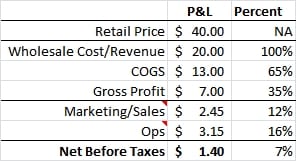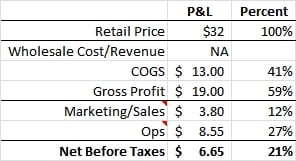Take a look at the following back-of-the napkin P&L. This is from an actual early-stage business.
 The product retails for $40 and wholesale cost is $20, which is the gross revenue to the business. COGS is fairly hefty because the business is small and does not yet have the volume to bring down its production costs. Marketing and sales is 35%, which is 15% for retailer fees and co-op and the rest for marketing, while operations is 45%, Net is 7%.
The product retails for $40 and wholesale cost is $20, which is the gross revenue to the business. COGS is fairly hefty because the business is small and does not yet have the volume to bring down its production costs. Marketing and sales is 35%, which is 15% for retailer fees and co-op and the rest for marketing, while operations is 45%, Net is 7%.
That is not bad for a small early-stage business. Actually, it’s quite good. Note that startup and investment costs, such as patent filings, product development, and marketing and brand development have been excluded. But from a purely operating perspective, it is making money to eventually pay back those startup and investment costs.
This P&L is somewhat standard for a lot of consumer product startups that sell at retail. High margin going to the retailer, high COGS, high operating costs and low or negative net income.
Now take a look at this second P&L. Same business but with some different assumptions about distribution structure.
 Retail price went down, but there is no retailer so it flowed directly to the wholesaler. No retailer and no 15% in retailer fees and co-op, but operations went up by 15% to account for added administrative help to support sales, so that is a wash.
Retail price went down, but there is no retailer so it flowed directly to the wholesaler. No retailer and no 15% in retailer fees and co-op, but operations went up by 15% to account for added administrative help to support sales, so that is a wash.
What changed was that the company is now selling direct, bypassing the retailer, giving them a competitive advantage in consumer products. Not only can it drop its retail price to better compete, but it can capture that margin that normally flows to the retailer. This is the basic advantage for going direct.
We think of online as the primary way to sell direct, and that would be correct. But online has its own challenges, like search engine optimization, shipping costs, latency from ordering product to delivery, and inability to touch the product on screen. Further, there is limited ability for a company to create a customer experience around the purchase, which is a critical selling point for brick/mortar.
Think about buying a kayak. I can research it online and possibly find the best price, but I can’t try it out. However, if I hop in my car and visit my REI in downtown Denver, I can see them, touch them and get in one, while I learn all the ins-and-outs from the people who work there selling kayaks. Maybe I can even demo one along the South Platte River at Confluence Park next to REI.
Can you see how the experience of getting a kayak is an important part of the purchase?
How can you combine the benefits of selling at retail but without the retailers and distributors who take margin? Try direct selling or selling through your own company-owned stores. Or, how about mobile stores, like those food trucks we see?
I don’t know much about these distribution methods, but have had the opportunity recently to learn more about them. What I like is that these distribution methods get a company’s products physically in front of a customer. Further, since there are no middlemen, the company keeps more of the margin, which gives flexibility in selling at a lower price relative to the competition, yet still maintain net income margins.
The company wins both ways – lower retail price at comparable quality to the competition, and yet higher net income. What a way to build a business! How much more awesome can it get than that!
So, can you change the distribution structure for competitive advantage in consumer products for your company? If so, what can you do with that advantage? Maybe you produce a higher quality product at comparable prices to your competition and position your brand and products on higher quality? Maybe you produce at comparable quality but now sell at a lower price. With more flowing to the bottom line, does that extra net income allow you to grow your business faster or develop that next product?





